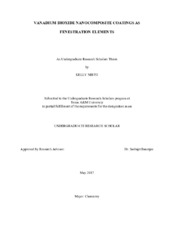| dc.description.abstract | Smart windows have attracted interest as a method of reducing the energy consumption of buildings. These smart windows would be able to reflect and transmit infrared (IR) light in response to ambient temperature, while also retaining the ability to transmit daylight. Vanadium dioxide is a prime candidate for use in smart windows due to the fact that its transition temperature of 67°C is far closer to room temperature than is typical of materials exhibiting a reversible metal—insulator transition; the transition temperature can be further depressed by introducing dopants. Above this transition temperature, vanadium dioxide switches from an insulator to metal and is able to reflect IR light. This characteristic would efficiently cut down energy consumption, as the smart windows would be able to regulate temperatures inside of buildings with reduced aid of air-conditioning systems. Vanadium dioxide alone produces a very poor film and therefore must be interfaced with a different material for practical application. Previously, our group found that silica matrices could be utilized to form films with VO2 via a modified Stöber method. These films were formed utilizing spray coating, and though somewhat successful, the method did not provide scalable or consistent films. Later, VO2 was dispersed in thickening agents to further stabilize dispersions and casting was performed with a casting knife, which improved film consistency. In this work we are focusing on functionalizing the surface of VO2 or VO2@SiO2 nanocrystals in solution with a perfluorinated silane that will work in tandem with fluorinated surfactants to disperse these materials within acrylic acid matrices. Surface functionalization of the VO2 will protect the material from oxidation as well as allowing the use of a surfactant to reduce agglomeration, which has been found to be a problem in previous work, thereby yielding a more homogeneous distribution of particles within films. Optimization of the Stöber method by changing experimental parameters related to the shell precursor and catalyst were investigated to reduce the overall agglomeration of VO2 nanoparticles in the silica shell. | en |


